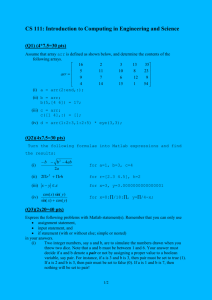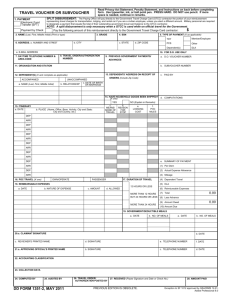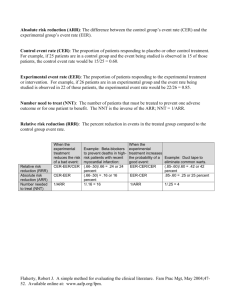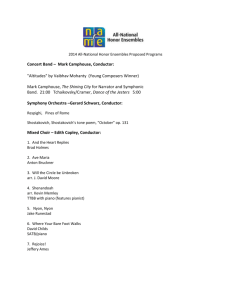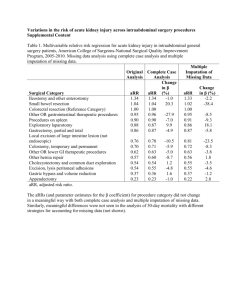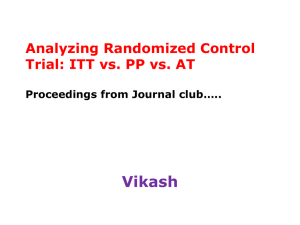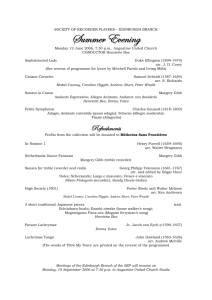Exercise 2.3
advertisement
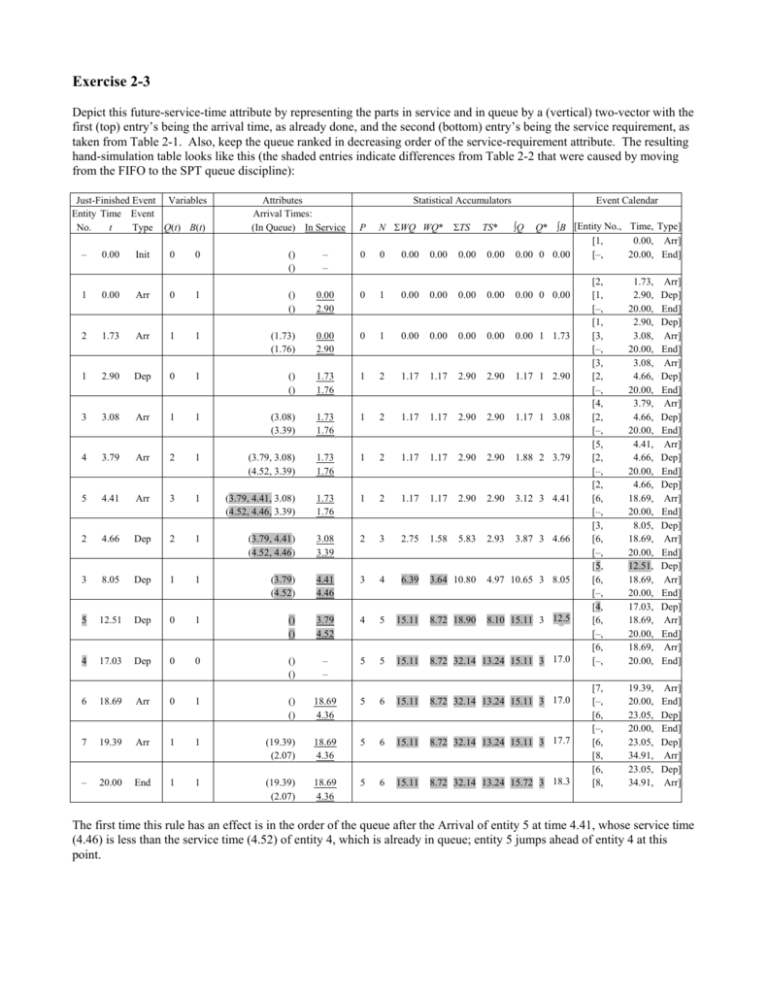
This file was downloaded from the Solutions area of the website for the 3d ed. of "Simulation With Arena" by Kelton, Sadowski, and Sturrock. Exercise 2-3 Depict this future-service-time attribute by representing the parts in service and in queue by a (vertical) two-vector with the first (top) entry’s being the arrival time, as already done, and the second (bottom) entry’s being the service requirement, as taken from Table 2-1. Also, keep the queue ranked in decreasing order of the service-requirement attribute. The resulting hand-simulation table looks like this (the shaded entries indicate differences from Table 2-2 that were caused by moving from the FIFO to the SPT queue discipline): Just-Finished Event Variables Entity Time Event No. t Type Q(t) B(t) Attributes Arrival Times: (In Queue) In Service Statistical Accumulators P N ΣWQ WQ* ΣTS Event Calendar – 0.00 Init 0 0 () () – – 0 0 0.00 0.00 0.00 0.00 Q* ∫B [Entity No., Time, Type] [1, 0.00, Arr] 0.00 0 0.00 [–, 20.00, End] 1 0.00 Arr 0 1 () () 0.00 2.90 0 1 0.00 0.00 0.00 0.00 0.00 0 0.00 2 1.73 Arr 1 1 (1.73) (1.76) 0.00 2.90 0 1 0.00 0.00 0.00 0.00 0.00 1 1.73 1 2.90 Dep 0 1 () () 1.73 1.76 1 2 1.17 1.17 2.90 2.90 1.17 1 2.90 3 3.08 Arr 1 1 (3.08) (3.39) 1.73 1.76 1 2 1.17 1.17 2.90 2.90 1.17 1 3.08 4 3.79 Arr 2 1 (3.79, 3.08) (4.52, 3.39) 1.73 1.76 1 2 1.17 1.17 2.90 2.90 1.88 2 3.79 5 4.41 Arr 3 1 (3.79, 4.41, 3.08) (4.52, 4.46, 3.39) 1.73 1.76 1 2 1.17 1.17 2.90 2.90 3.12 3 4.41 2 4.66 Dep 2 1 (3.79, 4.41) (4.52, 4.46) 3.08 3.39 2 3 2.75 1.58 5.83 2.93 3.87 3 4.66 3 8.05 Dep 1 1 (3.79) (4.52) 4.41 4.46 3 4 6.39 3.64 10.80 4.97 10.65 3 8.05 5 12.51 Dep 0 1 () () 3.79 4.52 4 5 15.11 8.72 18.90 8.10 15.11 3 12.5 4 17.03 Dep 0 0 () () – – 5 5 15.11 8.72 32.14 13.24 15.11 3 17.0 6 18.69 Arr 0 1 () () 18.69 4.36 5 6 15.11 8.72 32.14 13.24 15.11 3 17.0 7 19.39 Arr 1 1 (19.39) (2.07) 18.69 4.36 5 6 15.11 8.72 32.14 13.24 15.11 3 17.7 – 20.00 End 1 1 (19.39) (2.07) 18.69 4.36 5 6 15.11 8.72 32.14 13.24 15.72 3 18.3 TS* ∫Q [2, [1, [–, [1, [3, [–, [3, [2, [–, [4, [2, [–, [5, [2, [–, [2, [6, [–, [3, [6, [–, [5, [6, [–, [4, [6, [–, [6, [–, 1.73, 2.90, 20.00, 2.90, 3.08, 20.00, 3.08, 4.66, 20.00, 3.79, 4.66, 20.00, 4.41, 4.66, 20.00, 4.66, 18.69, 20.00, 8.05, 18.69, 20.00, 12.51, 18.69, 20.00, 17.03, 18.69, 20.00, 18.69, 20.00, Arr] Dep] End] Dep] Arr] End] Arr] Dep] End] Arr] Dep] End] Arr] Dep] End] Dep] Arr] End] Dep] Arr] End] Dep] Arr] End] Dep] Arr] End] Arr] End] [7, [–, [6, [–, [6, [8, [6, [8, 19.39, 20.00, 23.05, 20.00, 23.05, 34.91, 23.05, 34.91, Arr] End] Dep] End] Dep] Arr] Dep] Arr] The first time this rule has an effect is in the order of the queue after the Arrival of entity 5 at time 4.41, whose service time (4.46) is less than the service time (4.52) of entity 4, which is already in queue; entity 5 jumps ahead of entity 4 at this point. The final output performance measures, corresponding to Table 2-3, are: Performance Measure Total production Average waiting time in queue Maximum waiting time in queue Average total time in system Maximum total time in system Time-average number of parts in queue Maximum number of parts in queue Drill-press utilization Value Result from Table 2-3 Change 5 parts 5 parts No change 2.52 minutes per part (6 parts) 8.72 minutes 2.53 minutes per part (6 parts) 8.16 minutes Decreased 6.43 minutes per part (5 parts) 13.24 minutes 6.44 minutes per part (5 parts) 12.62 minutes Decreased 0.79 part 0.79 part No change 3 parts 3 parts No change 0.92 (dimensionless proportion) 0.92 (dimensionless proportion) No change Increased Increased The effect of SPT rather than FIFO is for the average waiting time in queue and the average total time in system to go down (get better), while the maximum of these two measures went up (got worse), since the large jobs get stuck at the back of the queue for a long time. Thus, whether this is “better” depends on the performance measure It would also be possible to put entities into the queue at the end and then do a search on the service-requirement attribute to decide which entity to remove; this would be somewhat more computation, though, since inserting the entity in the right place will generally require searching less than the whole queue, while picking the minimum-service-requirement entity out of an unordered queue will always require searching the entire queue to be sure we get the minimum.
